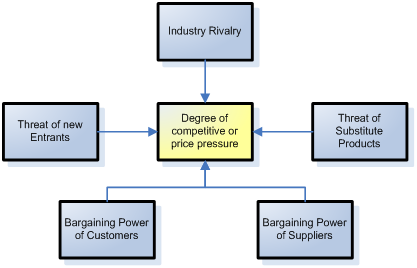Industry Analysis is a strategic tool
 Industry analysis is a strategic tool designed for market assessment to provide a business with an idea about complexity of a particular industry. The industry analysis involves reviewing the economic, political and market factors that influence the way the industry has developed and is performing. Major factors include the power exerted by buyers and suppliers, how competitive the market is and the likelihood of new entrants. Small as well as big businesses often spend a large chunk of time planning their firm’s operations. Majority of that time is spent planning initial operations and expected financial returns. Once the business is in progress, business owners continue the planning process to ensure their venture remains profitable. Industry analysis is an important part of a business planning. This analysis often looks at the external factors that can affect a company.
Industry analysis is a strategic tool designed for market assessment to provide a business with an idea about complexity of a particular industry. The industry analysis involves reviewing the economic, political and market factors that influence the way the industry has developed and is performing. Major factors include the power exerted by buyers and suppliers, how competitive the market is and the likelihood of new entrants. Small as well as big businesses often spend a large chunk of time planning their firm’s operations. Majority of that time is spent planning initial operations and expected financial returns. Once the business is in progress, business owners continue the planning process to ensure their venture remains profitable. Industry analysis is an important part of a business planning. This analysis often looks at the external factors that can affect a company.
Industry analysis enables a company to develop competitive strategies to survive in a market and using the forces in its favor. The key to developing a competitive strategy is to understand the sources of the competitive forces. By developing an understanding of these competitive forces, the company can:
- Emphasize on its strengths, weaknesses, opportunities and threats (SWOT).
- Elevate its position in the industry.
- Clarify areas where strategic changes will result in the greatest payoffs.
- Emphasize areas where industry trends indicate the greatest significance as either opportunities or threats.
- Trim down weaknesses and threats by using competitive advantages.
Everything that goes on in the industry and the external factors affect the businesses existing businesses. Therefore a better understanding of the industry helps a business survive better. More understanding of the industry highlights chances of prosperity for a business as it has more advantage and protection. While preparing a business plan the general industry economics, participants, distribution patterns, factors in the competition is described to portray the survival and growth of a business. The internet has created an enormous impact on the state of industry information. Finding information isn’t really a problem anymore. Today at click of button, loads of information is accessed by anybody. The Internet has brought in a lot of transparency. Two decades back, dealing with information was more of a problem of sorting through it all than of finding raw data. Today, there are websites for business analysis, financial statistics, demographics, government policies, trade associations, suppliers, buyers, supply chain managers – you name it and just about everything and you will have access to all that is required for making a business plan and industry analysis.
For making an accurate industry analysis you must know:
Industry participants: You should know who else sells in your market. You can’t easily describe a type of business without describing the nature of the participants. There is a huge difference, for example, between an industry like broadband television services, in which there are only a few huge companies in most of the countries, and one like dry cleaning, in which there are tens of thousands of smaller participants. The participants in the industry have their own style of running their businesses. The leaders in the industry call the shots. The procedures in the industry can change suddenly, which in turn can challenge operations of many smaller companies. Today we see that the fast food business is composed of a few international brands participating in thousands of branded outlets, many of them are franchised. We have a gamut of local, national and multi-national chains evolved and the scenario which looks very competitive.
Economists talk of consolidation as an encouraging economic parameter; we see smaller participants disappearing from the market and a few large players emerging. In accounting, the majority of the world’s auditing services are performed by only four accounting firms. Known as the ‘Big 4’, these firms completely dominate the industry, auditing more than 80 percent of all US public companies. In addition, these mammoth organizations advise on tax and offer a wide range of management and assurance services. They are Deloitte LLP, PricewaterhouseCoopers, Ernst & Young and KPMG.
The last major change to the fortunes of the global accounting firms followed the collapse of the Enron Corporation which was audited by Arthur Anderson. In the outcome of the collapse, the accounts company was found guilty of criminal charges relating to its business practices. Although the conviction was eventually overturned, the damage to its reputation meant Arthur Andersen was unable to recover and eventually sold most of its business to members of what would come to be known as the Big 4.
Distribution Pattern: Products and services can follow many paths between suppliers and users. One needs to know how distribution works in an industry. Each sector has its distribution pattern set. One needs to see whether in a particular industry retailers are supported by regional distributors, as is the case for computer products, magazines, or auto parts. Does an industry depend on direct sales to large industrial customers? Do manufacturers support their own direct sales forces, or do they work with product representatives? Brilliant marketing logistics covers physical distribution plus managing marketing channels. The importance of transportation to economic growth and productivity is undisputed. Transportation confers place-utility and time-utility to products and services. At the macro level, progressive transportation modes contribute handsomely to the national economy. At the micro level, techniques have been developed and refined for determining the economic impact of transportation programs and projects. It has been observed that there is a shift in hiring services of contracted and third party transporters by many organizations.
Some products are almost always sold through retail stores to consumers, and sometimes these are distributed by distribution companies that buy from manufacturers. In other cases, the products are sold directly from manufacturers to stores. Some products are sold directly from the manufacturer to the final consumer through mail campaigns, national advertising, or other promotional means.
In many product categories there are several alternatives, and distribution choices are strategic. Encyclopedias and vacuum cleaners are traditionally sold door-to-door, but are also sold in stores and direct from manufacturer to consumer through radio and television ads.
Technology can change the patterns of distribution in an industry or product category. The internet, for example, changed options for software distribution, books, music, and other products. Cable communication is changing the options for distributing video products and video games. Distribution patterns may not be as critical to most service companies, because distribution is normally about physical distribution of specific physical products such as a restaurant, graphic artist, professional services practice, or architect.
So far the pharmaceutical companies used to sell medicine stocks directly to 5000 odd stockiest and distributors, they in turn sell the products to 10000 wholesalers and the wholesalers then sell them to six lakh retailers. This trade practice has been existed in the industry for several years and All India Organization of Chemists & Druggists (AIOCD) was directly controlling this arrangement disliked by many pharma companies and patient community.
Industry sources said that the new order in the pharmaceutical trade is going to be in place in Maharashtra to start with. The representatives of the pharma trade and industry had a meeting with the Commissioner of Food & Drug Administration last week and he is understood to have told the industry and trade that no wholesaler should be denied direct supplies of drugs by the manufacturer. Denial of drug supply to any wholesaler would amount to restrictive trade practice and will be in violation of the Drug Price Control Order and Competition Act attracting penal action. The new distribution system will be enforced by other states also shortly. Drug manufacturers are not however happy with the new distribution system as they may have to deal with a large number of wholesalers now onwards and that may add to additional costs.
Competition: It is essential to understand the nature of competition in your industry. This is still in the general area of describing the industry or type of business. Explain the general nature of competition in this business, and how the customers seem to choose one provider over another. What are the keys to success? What buying factors make the most difference? Is it price? Product features? Is it service? Support, training, delivery schedules what is it? Are brand names important in the market? Which are the leading brands, why are they leading? What positioning strategies have been used by the marketers? So you see there is so much to find out about the competition.
 The market is determined by supply and demand. Creating and maintaining relationship with customers is become an inseparable part of business. The concept of CRM is viewed differently in different sectors of business. Customer relationship or customer care is not just being polite to them – it is looking at the entire customer experience – or walking in the shoes of the customers. This journey starts before you even meet your customer, the trick is to forget all that you know or think you know about the market. Start thinking why your customers would want to buy your product? How it would solve their problems? How the substitute product would satisfy their needs? How you product reaches them in time? With companies offering technology-based solutions for everything, customer care has become more important than ever before. Sales literature and indeed entire campaigns are based on describing the technology, usage, power of the product, marketing channel details, price points etc.
The market is determined by supply and demand. Creating and maintaining relationship with customers is become an inseparable part of business. The concept of CRM is viewed differently in different sectors of business. Customer relationship or customer care is not just being polite to them – it is looking at the entire customer experience – or walking in the shoes of the customers. This journey starts before you even meet your customer, the trick is to forget all that you know or think you know about the market. Start thinking why your customers would want to buy your product? How it would solve their problems? How the substitute product would satisfy their needs? How you product reaches them in time? With companies offering technology-based solutions for everything, customer care has become more important than ever before. Sales literature and indeed entire campaigns are based on describing the technology, usage, power of the product, marketing channel details, price points etc.
In the computer business, for example, competition might depend on reputation and trends in one part of the market, and on channels of distribution and advertising in another. In many business-to-business industries, the nature of competition depends on direct selling, because channels are impractical. Price is vital in products competing with each other on retail shelves, but delivery and reliability might be much more important for materials used by manufacturers in volume, for which a shortage can affect an entire production line.
Market leaders: The market leader is dominant in its industry and has substantial market share. If you want to lead the market, you must be the industry leader in establishing an innovation friendly organization, developing new business models and new products or services. The market leaders usually have the cutting edge technologies. They offer superior solutions to the customer’s problems. And, most importantly their products are well differentiated. Market ledgers have an edge over the other players in the market. They make the strategic changes and changes in the policies. The following graph shows strengths and challenges in the construction sector of India.
 India is on the verge of witnessing a sustained growth in infrastructure build up. The construction industry has been witness to a strong growth wave powered by large spends on housing, road, ports, water supply, and rail transport and airport development. While the construction sector’s growth has fallen as compared to the pre-2008 period, it has picked up in the recent past. Its share as a percentage of GDP has increased considerably as compared to the last decade. To put things in perspective, the total investment in infrastructure – which in this case also includes roads, railways, ports, airports, electricity, telecommunications, oil gas pipelines and irrigation – is estimated to have increased from 5.7% of GDP in 2007 to around 8.0% by 2012. The Planning Commission of India has proposed an investment of around US$ 1 trillion in the Twelfth five-year plan (2012-2017), which is double of that in the Eleventh five-year plan.
India is on the verge of witnessing a sustained growth in infrastructure build up. The construction industry has been witness to a strong growth wave powered by large spends on housing, road, ports, water supply, and rail transport and airport development. While the construction sector’s growth has fallen as compared to the pre-2008 period, it has picked up in the recent past. Its share as a percentage of GDP has increased considerably as compared to the last decade. To put things in perspective, the total investment in infrastructure – which in this case also includes roads, railways, ports, airports, electricity, telecommunications, oil gas pipelines and irrigation – is estimated to have increased from 5.7% of GDP in 2007 to around 8.0% by 2012. The Planning Commission of India has proposed an investment of around US$ 1 trillion in the Twelfth five-year plan (2012-2017), which is double of that in the Eleventh five-year plan.
Besides Indian Railway Construction Limited (IRCON), National Buildings Construction Corporation (NBCC), Rail India Transportation and Engineering Services (RITES), Engineers India Limited (EIL), in private sector M N Dastur and Co, Hindustan Construction Company (HCC), L&T and GVK are leaders.
Industry reports are prepared by the following:
Government Agencies: They prepare and compile various industry reports to judge the overall economic health of the nation. Examples of these are reports by the Bureau of Labor Statistics (BLS) and International Monetary Fund (IMF).
Research Firms: These firms conduct market surveys and compile different industry reports and sell them to companies and government organizations. These reports are purchased to facilitate decision making. Firms such as PWC, Ernst & Young, IMBR are famous for preparing industry analysis reports.
Individual Companies: Different companies in an industry prepare industry reports for their own use in order to facilitate decision marking and internal management. These industry reports are generally not available to outsiders.
An Industry report consists of the following elements:
Industry definition: An industry report includes a comprehensive definition of the industry, mentioning what the industry includes and what comes outside its purview.
Major industry players: It mentions the names and other relevant information about major companies that generate the largest revenue in the industry.
Market share: The report presents a breakdown of the different markets of the industry and its share in each market.
Historical and current trends: These trends include the facts and figures (such as revenue, sales and profits) of various companies in the industry. Historical trends in the industry are generally presented for five to ten years and the current trend pertaining to the prior financial year.
Employment statistics: It includes an account of the total employment figures and distribution in different companies within the industry. Key statistics also include the composition of men and women in the labor force.
SWOT analysis: This is an overall analysis of the industry in terms of its strengths, weaknesses, opportunities and threats.
Achievements: It mentions the significant milestones and achievements of the industry. This could include new innovations in the industry or the industry’s contribution to social-economic development.
 Outlook: The report includes the prospects of the existing companies in the industry as well as the scope for new players.
Outlook: The report includes the prospects of the existing companies in the industry as well as the scope for new players.
An industry report contains graphs, charts and tables, generally supported by written commentary. This enables even non-professionals to get an understanding of the industry.
Some important insights such as low cost production structure (compared to the industry cost structure) could be through economies of scale or other operational efficiencies, strong technology capability, location to customers (if close, time to deliver to market will be relatively fast and shipping costs will be low) and sustainability of the business if taken into account in analyzing the industry will be of great help.
It is critical that you understand what an industry’s key success factors are; the only way to discover them is to do a thorough industry analysis.












































